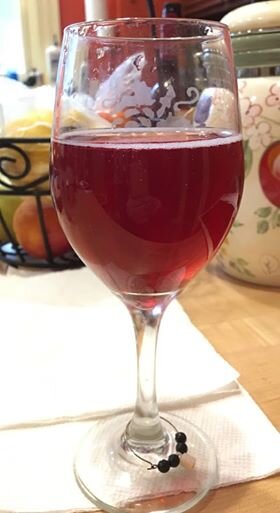Efficient Home Winemaking: Don’t let Your Leftover Grape Skins go to Waste!
Home Winemaking Problem Solving: What to do with the Wine Grape Pomace?
So you’ve pressed off your delicious red wine and now have a big pile of grape skins. Instead of throwing them away, take a look at these four ideas and start making full use your grape skins!
Wine grape pomace top soil four months after dispersal. Do you see the sprouting vines?
1. Use the Wine Pomace to Make Fertilizer or Top Soil
Did you know that roses love slightly acidic soil in the 6.0-6.9 pH range? Your leftover grape skins are perfect for lowering the pH in your soil so that your roses and other acid loving plants can thrive! You may have too high a pH if your plants are showing signs of chlorosis (a yellowing of the leaves). Gardenias, Rhododendrons, and even blueberries will also appreciate the lower pH provided by the pomace. We also quite enjoy the fine aroma of the must, as well as watching the little birds dig and scrape in the skins for grape seeds. After 3 to 4 months, the grape skins will be close to fully broken down (see picture). Here is the best part, this use of the skins is super easy! Just grab a shovel and spread the grape skins around your plant bed.
Mead infused with the flavors and color of grape pomace. Photo courtesy of Dan Mouer.
2. Add Complex Flavors and Rich Color to Your Next Batch of Beer or Mead
Infuse your next batch of mead or beer with grape skins to add that next layer of complexity to your brew. A WineGrapesDirect customer, Dan Mouer of Virginia, was kind enough to share his grape infused mead recipe: Mix 9 pounds of honey with water to make five gallons of mead. Then pour the mixture over the skins, seeds and lees from one bucket of pressed grape must. This will ferment dry over a few weeks. Later, prime with honey and bottle as a sparkler. For fruit lambics or cherry Flanders Browns, simply rack the beer to an open (bucket) secondary and add the fruit directly. It usually takes a while for the fruit fermentation to complete. Then strain through a mesh bag and rack to a carboy. Be sure that all the small fruit bits and pectin globules settle out. Depending on the fruit, a bit of pectinase stirred in a few days before fining works wonders.
Roman wine amphora pulled from a shipwrecked cargo vessel bound for France. Perhaps it once contained piquette? Photo Courtesy of the Metropolitan Museum of Art, Click for More Details
3. Make a second run wine!
In the middle ages, pomace wine was very common and was an affordable 6% alcohol beverage available to the masses. They did not add any sugar, as there was already enough residual sugar in the pomace because most wines were not fermented to dryness at the time. The ancient Romans and Greeks also made pomace wine, but called it piquette. Making pomace wine is very easy. Simply mix sugar with water to raise your brix to at least 22. Remember, .125 pounds of sugar raises 1 gallon of water by 1 brix. Just don’t expect a great product at the end, as the result is normally a lesser wine. Commercial distilleries will also use both pomace (Grappa in Italy or Marc in France) and pomace wine (brandy) to make spirits.
Cheesemaking – Photo Courtesy of bluesy seenery – Link
4. Add both Flavor and Color While also Protecting Your Homemade Cheese
Are you making cheese at home or know someone who does? Then try adding the rich flavor of the grape skins to your homemade cheese by covering your cheese tomme in grape must pomace. This method is very old and used in both France and Italy. In France, the most popular variety is called Tomme au Marc. This cheese is covered in grape must pomace and tightly sealed. After two months of aging, the cheese is removed and dried. The result is a beautiful cheese covered in grape skins and seeds that has the rich complex flavors found only in wine grapes. Cheesmaking.com has a recipe HERE.
Are you using your pomace in other ways? Please write to us, andrew@winegrapesdirect.com, as we’d love to make even more use of our wine must pomace!



